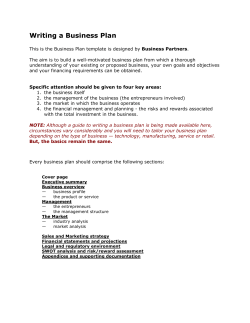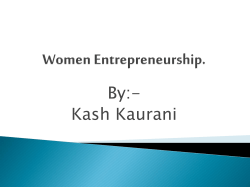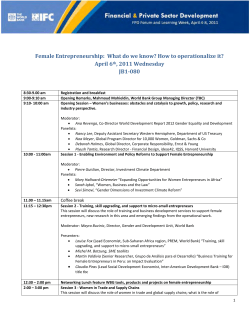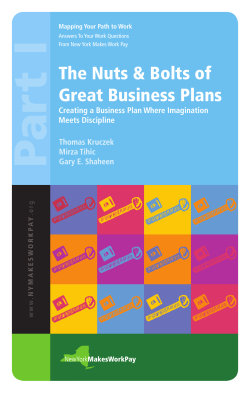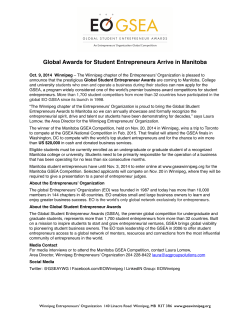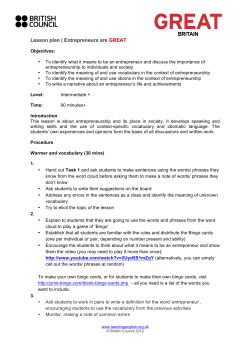
Senior Contest: "Building a Business": Lesson Plan
Senior Contest: "Building a Business": Lesson Plan Business Studies Lesson: The lesson focuses on courses in Entrepreneurship, but could also be useful in Introduction to Business, International Business, Marketing, and Business Leadership. Goal(s): To help students become familiar with Canada’s first entrepreneurs. To demonstrate the impact of early entrepreneurs on the development of Canada. To analyse the characteristics and contributions of enterprising people. To demonstrate the relationship between business and history. To provide an opportunity for students to think about whether entrepreneurs are agents of change or simply people who react to change. Objectives: Identify Canada’s early entrepreneurs. Develop a profile of the early entrepreneurs (e.g., characteristics, skills, motivations, attitudes, contributions). Compare early entrepreneurs with entrepreneurs today (e.g., similarities, differences) Timeline: two 76-minute periods Required Materials: Internet access: (e.g., computer lab, student smart phones, tablets, laptops etc....) Copy of reading card: one for each student Copy of scavenger hunt: one for each student Teacher Note: The answers and the locations of the answers to the scavenger hunt are provided on the answer sheet. Similar answers may be found on multiple pages of the hbcheritage.ca website. The Answer Sheet contains URLs for some of the pages where the answer can be found. As well, keywords are indicated in bold in the questions. A search for the keywords should reveal a page where the answer can be found. Bolded dates mean that answers can be found on the timeline under the date. Instructions Period 1 Classroom Discussion Briefly at an introductory level discuss with the students as a group: (What makes someone an entrepreneur?) Let the students come up with what they think an entrepreneur is and why, giving examples of entrepreneurs (e.g. local, national or international examples), (e.g. characteristics of an entrepreneur). The teacher or a student can make a list of the main points and examples given on the smartboard or somewhere the list can be saved for future recall. 10 min. Reading Card Distribute one reading card to each student. Allow 5-10 minutes for reading. The teacher should announce to the class that they are now going to go on a scavenger hunt to discover the opportunities and entrepreneurs that created and guided HBC’s business across the centuries. They are also entering a contest and may win a prize. Student Activity Distribute the Scavenger Hunt questions. Organize the class into small groups. Using the information available at www.hbcheritage.ca and the timeline and search function, have students find the answers to the scavenger hunt provided with this lesson. Use a computer lab or allow students to use whatever devices they have available in the classroom to access the internet, (e.g. smart phones, tablets, laptop, etc....). Ask students to keep track of where they found the answers (e.g. timeline year, title of link and paragraph number) for verification of answers when we return to full class discussion of the scavenger hunt. Depending on the number of Internet devices available you could have students work on the scavenger hunt individually or assign specific questions to individuals or groups. 35-40 min. Full Class Discussion Using the internet (e.g. smartboard or projector with computer) go to www.hbcheritage.ca so all students can see the website. Have students discuss their answers to the scavenger hunt, verifying where they found the answer (e.g. year on the timeline, title of link and paragraph number). Looking at the website so all students can see, go to the suggested location and check out the answer given. Have students agree on the answer they feel is correct. Using the answers the class has decided upon, complete one copy of the scavenger hunt. Submit one copy from the class for the scavenger hunt contest. Only one copy per class will be accepted. 20 min. Period 2 Classroom Discussion Recall the list the class made re: What makes someone an entrepreneur? Now that we have completed the scavenger hunt activity and have had an opportunity to learn about a few early Canadian entrepreneurs, discuss the list with the students, adding or subtracting points based on our new knowledge and experience. Discuss the similarities/differences between entrepreneurs of today and the entrepreneurs like Radisson, des Groseilliers, George Simpson, Donald Smith, Robert Simpson, Walter Zeller and Joe Segal. Note taking: Now have the students put the following titles in their notebook: What makes someone an entrepreneur? Students can now write a sentence in their own words. List five examples of entrepreneurs, especially ones you can identify with or know something about (e.g., local, national, or international) List five characteristics of an entrepreneur. Use the revised list we created as a class to help you complete the above. Assessment and Evaluation: Have students: Write a short reflection on their own entrepreneurial abilities (e.g., skills, experiences, characteristics, things I am good at and things I can work on). What did you learn about entrepreneurs from this lesson that you didn’t know before? The teacher can briefly review the reflections as an opportunity to assess for learning. Supplemental Activities: As part of a critical thinking exercise ask students in groups of three to come to a decision on the question: Are entrepreneurs agents of change or simply people who react to change? Each group can report back to the class with a clearly stated viewpoint, backing it up with a persuasive argument and examples to support their point of view. Web resource: www.hbcheritage.ca
© Copyright 2025


